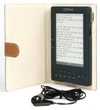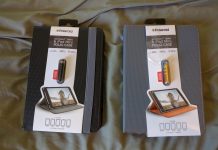 Last night, Paul Biba startled me with an offer: he had received a review unit of Astak’s 5” Pocket PRO EZ Reader, but did not have the time to review it. Did I want to?
Last night, Paul Biba startled me with an offer: he had received a review unit of Astak’s 5” Pocket PRO EZ Reader, but did not have the time to review it. Did I want to?
Did I ever‽ This will make a great opportunity to compare this competing e-book reader to what I remember of the Sony. With that in mind, I am starting a new series of columns: Two weeks with an Astak 5”.
I actually expect to have this reader longer than two weeks—Paul believed it was mine to keep, though I will try not to get too attached to it just in case—but I think two weeks is an ample time to do all the reviewing I need, and the similar naming will keep the categories together in the list.
(Editor’s note: Chris will honestly review the Astak no matter what happens. But for journalistic reasons, we’ll figure out another way to reward his much-appreciated efforts. – D.R.)
Since I should have the unit before noon tomorrow, I am in much the same situation now as when I wrote this post before receiving the Sony PRS-700. And I find I still feel much the same way.
The Astak is probably not the e-book reader I would buy for myself, if I were buying one myself, due to its lack of wireless connectivity. But on the other hand, if I do get to keep this device, I will absolutely use the hell out of it. There is not anything wrong with e-ink’s legibility, after all, and loading from my computer will not be that great a hardship.
And to be fair, if I disregarded the wireless issue, there is a lot to like about the Astak’s specs.
For starters, it has the same resolution as its 6”-screened brethren, but in a 5” screen. That means the letters should be that much sharper, since there will be more dots per inch. It will have eight greyscale levels, multiple ways of paging down including a scroll wheel, and an SD card slot for external book storage.
Furthermore, the Astak should not have that touch-sensitive screen blur and glare layer that the PRS-700 had. I am looking forward to seeing for myself exactly how clear e-ink can be. And the feature list says that it has text-to-speech capability, at least for un-DRM’d books. It will be interesting to hear how that sounds.
As for file formats, the Astak claims to support “ADE (Adobe Digital Editions), PDF, DOC, RTF, HTML, TXT, MP3, WOL, CHM, RAR, ZIP, FB2, DJVU, EPUB, BMP, JPG, TIF, PNG, GIF, PDB, PPT, LIT.” That’s quite a lot of alphabet soup. (Strangely, under “Features” it lists PRC but not PDB, and under “Specifications” it lists PDB but not PRC. Well, either way they probably just mean Mobipocket.)
The bad news is, it does not support eReader DRM (yet—I see elsewhere that they are working on adding eReader support), which is what a lot of my purchased e-books are in. And it sure isn’t going to support Kindle DRM. But the good news is that most of my other e-books either already are or are convertible to the open formats, so I’m already pretty good to go.
Although I am going to be busy this weekend running an animé and movie screening room at a local gaming convention, I will try to find the time to put it through its paces as soon as I can.
































“The bad news is, it does not support eReader DRM, which is what a lot of my purchased e-books are in.”
While one shouldn’t count on anything until we see it. They do plan to add eReader DRM support.
On the 6″ model PDB means DocReader format and it handles it well.
PRC means drm-free mobi.
Couldn’t you just strip the DRM from the ereader files and then convert them to something else using Calibre? In the long term, that might a good idea regardless, since it ensures that you can always read the books you’ve purchased, regardless of what device and formats become dominant.
Frode: Alas, U.S. law does not permit circumvention of DRM even for the legitimate purposes you describe. Would that it did! I’m jealous, jealous, jealous of people in countries where this is legal.
Thanks,
David
For your testing purposes PRC is the same as MOBI. (some claim the difference is DRM but that is not the case, both are the same but Mobipocket adopted the new extension to avoid confusion with other Palm applications that use PRC) PDB is unique to this device and is the old PalmDOC format. It works quite well by the way.
Actually wouldn’t this come under this exemption? (wiki entry for DMCA)
“Literary works distributed in e-book format when all existing e-book editions of the work (including digital text editions made available by authorized entities) contain access controls that prevent the enabling either of the book’s read-aloud function or of screen readers that render the text into a specialized format. (Revised from a similar exemption approved in 2003.)”
IANAL but provided the books you mentioned are not available in another format, I’d think that would pretty much cover your case.
Of related interest, that would also mean that it would be legal to remove the DRM from kindle books, if they limit the ability to use the text-to-speech feature.